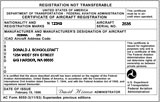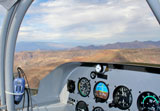|
Operating Limitations for Operating Kit Built Aircraft, R&D, Showing Compliance, Crew Training, and Market SurveysOperating limitations will be designed to fit the specific situation encountered, for example operating kit built aircraft. The Aviation Safety Inspector (ASI) may impose any additional limitations deemed necessary in the interest of safety. The ASI and/or DAR will review each imposed operating limitation with the applicant to ensure that the operating limitations are understood by the applicant. The following operating limitations will be prescribed as applicable: 1. No person may operate this aircraft unless Form 8130-7 is displayed at the cabin or cockpit entrance and visible to passengers or flightcrew members. (Applicability: All) 2. No person may operate this aircraft for other than the purpose of R&D, showing compliance with regulations, crew training, market surveys, or operating kit-built aircraft, to accomplish the flight operation outlined in the program letter dated ______, which describes compliance with FAR 21.193(d), and has been made available to the pilot in command of the aircraft. In addition, this aircraft must be operated in accordance with applicable air traffic and general operating rules of FAR 91, and all additional limitations herein prescribed under the provisions of FAR 91.319(e). (Applicability: All) 3. All flights must be conducted within the geographical area described as follows: The area must be described by radius, coordinates, and/or landmarks. The designated area must be over open water or sparsely populated areas having light air traffic. The size of the area must be that required to safely conduct the anticipated maneuvers and tests. Multiple-purpose certificates may require individually prescribed geographical areas. (Applicability: All) NOTE: This applies to all certificates issued to show compliance with FAR 91.319(b). When the FAA finds compliance, the operating limitations will be revised to remove the limitation. The aircraft will not be allowed to operate over densely populated areas or in congested airways in accordance with FAR 91.319(c). The FAA may permit takeoffs and landings to be conducted over densely populated areas or in congested airways. If this operating limitation is issued, it should say, “Except for takeoffs and landings, this aircraft must not be operated over densely populated areas or in congested airways.” Limitation No. 5 may be specified in lieu of this operating limitation for PC/APIS holders who have submitted a procedure. 4. All flights of this aircraft must be conducted within the geographic area indicated on the chart as follows: (Applicability: All except kit-built) NOTE: This limitation will be prescribed to expand the area after the FAA finds compliance with FAR 91.319(b). This limitation applies to the following purposes: R&D, showing compliance, crew training, and market surveys. Limitation No. 5 may be specified in lieu of this operating limitation for PC/APIS holders who have submitted a procedure. 5. All flights must be conducted in accordance with [describe the PC/APIS holder’s approved operating procedure, for example, ABC Aircraft Co. Experimental Operating Procedure No. 12 (dated)]. (Applicability: All except kit-built) NOTE: Limitation No. 5 may be specified in lieu of Nos. 3 and 4 for PC/APIS holders that have submitted a procedure. 6. When changing between operating purposes of a multiple-purpose certificate, the operator must determine that the aircraft is in a condition for safe operation and appropriate for the purpose intended. A record entry will be made by an appropriately rated person to document that finding in the aircraft logbook. (Applicability: All except kit-built) NOTE: This limitation is not applicable when a PC/APIS holder’s experimental operating procedure is specified. 7. This aircraft must not be operated unless it is inspected and maintained in accordance with appropriate military technical publications and/or manufacturer’s recommendations. The owner/operator must select, establish, identify, and use an inspection program as set forth in FAR 91.409(e), (f), (g), and (h). This inspection program must be recorded in the aircraft maintenance records. (Applicability: All except kit-built) 8. The pilot in command of this aircraft must hold an appropriate category/class rating. If required for the type of aircraft to be flown, the pilot in command also must hold either an appropriate type rating or a letter of authorization issued by an FAA Flight Standards Operations Inspector. (Applicability: All) NOTE 1: A letter of authorization is issued for all training and eligibility requirements. NOTE 2: This limitation is applicable to any turbine-powered or reciprocating engine-powered aircraft with a total power greater than 800 horsepower, rotorcraft, aircraft with a maximum takeoff weight exceeding 12,500 pounds, or any other aircraft when deemed necessary. 9. This aircraft is to be operated under VFR, day only. (Applicability: All) NOTE: FAR 91.319(d)(2) provides for VFR, day only. If other operations are requested, the authorization will be prescribed as a limitation by selecting operating limitation No. 10 and/or No. 11, as appropriate, and by deleting this limitation. The aircraft must also be equipped in accordance with FAR 91.205. 10. This aircraft may be operated under VFR, day and/or night. (Applicability: All) 11. This aircraft may be operated under IFR, and must be properly equipped for instrument flight in accordance with FAR 91.205. (Applicability: All) 12. No person may operate this aircraft for carrying persons or property for compensation or hire. (Applicability: All) 13. No person may be carried in this aircraft during flight unless that person is essential to the purpose of the flight.(Applicability: R&D and show compliance only) NOTE: This limitation may be deleted for PC/APIS holders and limitation No. 14 may be specified instead. 14. Persons may be carried in accordance with [describe the PC/APIS holder’s approved operating procedure, for example, ABC Aircraft Co. Experimental Operating Procedure No. 12 (dated)]. (Applicability: All except kit-built) NOTE: This limitation is applicable only for PC/APIS holders that have submitted a procedure. 15. The pilot in command of this aircraft must advise each passenger of the experimental nature of this aircraft, and explain that it does not meet the certification requirements of a standard certificated aircraft. (Applicability: All) 16. This aircraft must contain the placards, markings, etc., (or other operating instructions developed for an STC modification) required by FAR 91.9. (Applicability: All) NOTE: Inspectors also will identify the flight manual, flight manual supplements, markings, drawings, etc., as required. 17. This aircraft is prohibited from aerobatic flight, that is, an intentional maneuver involving an abrupt change in the aircraft’s attitude, an abnormal attitude, or abnormal acceleration not necessary for normal flight. (Applicability: All) NOTE: Aerobatic flights may be permitted in the assigned test area. The applicant should be advised that aerobatics or violent maneuvers should not be attempted until sufficient flight experience has been gained to establish that the aircraft is satisfactorily controllable. These operating limitations may be modified to include only those aerobatics/maneuvers that have been satisfactorily accomplished and recorded in the aircraft records during the flight test period. These aerobatics/maneuvers may be permitted upon leaving that assigned test area. Appropriate limitations identifying the aerobatics/maneuvers and conditions under which they may be performed should be prescribed. The FAA may witness aerobatics/maneuvers if deemednecessary. 18. This aircraft may conduct aerobatic flight in accordance with FAR 91.303. Aerobatics must not be attempted until sufficient flight experience has been gained to establish that the aircraft is satisfactorily controllable and in compliance with FAR 91.319(b). Aerobatic maneuvers intended to be performed must be satisfactorily accomplished and recorded in the aircraft records during the flight test period. (Applicability: All) 19. The cognizant FSDO must be notified, and its response received in writing, prior to flying this aircraft after incorporation of a major change as defined by FAR 21.93. (Applicability: All except for R&D and show compliance) NOTE: Limitation No. 5 may be specified in lieu of this limitation for PC/APIS holders that have submitted a procedure. 20. This aircraft must not be used for glider towing, banner towing, or intentional parachute jumping. (Applicability: All) 21. No person must operate this aircraft unless within the preceding 12 calendar months it has had a condition inspection performed in accordance with FAR 43 Appendix D, or other FAA-approved programs, and was found to be in a condition for safe operation. This inspection will be recorded in the aircraft maintenance records. (Applicability: All) 22. Only FAA-certificated mechanics with appropriate ratings as authorized by FAR 43.3 may perform inspections required by these operating limitations. (Applicability: All) 23. Inspections must be recorded in the aircraft maintenance records showing the following, or a similarly worded, statement: “I certify that this aircraft has been inspected on [insert date] in accordance with the scope and detail of FAR 43 Appendix D, or other FAA-approved programs, and was found to be in a condition for safe operation.” The entry will include the aircraft’s total time-in-service, and the name, signature, certificate number, and type of certificate held by the person performing the inspection. (Applicability: All) 24. If aircraft, engine, or propeller operating limitations are exceeded, an appropriate entry will be made in the aircraft records. (Applicability: All except kit-built) NOTE: This limitation applies only when an aircraft is temporarily in the experimental category and will be returned to the original certificate status, for example, STC project. 25. This aircraft must not be operated unless it is maintained and inspected in accordance with the requirements of part 43.(Applicability: All) NOTE: This operating limitation is applicable to any aircraft that previously had been issued a different type of airworthiness certificate prior to applying for a special airworthiness certificate (reference FAR 43.1(b)). 26. This aircraft must display the word “EXPERIMENTAL” in accordance with FAR 45.23(b). (Applicability: All) 27. The pilot in command of this aircraft must notify air traffic control of the experimental nature of this aircraft when operating into or out of airports with operating control towers. The pilot in command must plan routing that will avoid densely populated areas and congested airways when operating VFR. (Applicability: All) 28. This aircraft does not meet the requirements of the applicable, comprehensive, and detailed airworthiness code as provided by Annex 8 to the Convention on International Civil Aviation. The owner/operator of this aircraft must obtain written permission from another country’s CAA prior to operating this aircraft in or over that country. That written permission must be carried aboard the aircraft together with the U.S. airworthiness certificate and, upon request, be made available to an FAA inspector or the CAA in the country of operation. (Applicability: All) 29. Aircraft instruments and equipment installed and used under § 91.205 must be inspected and maintained in accordance with the requirements of parts 43 and 91. Any maintenance or inspection of this equipment must be recorded in the aircraft maintenance records. (Applicability: All) 30. Application must be made to the geographically responsible FSDO or MIDO [insert name of office] for any revision to these operating limitations. (Applicability: All) 31. Section 47.45 requires that the FAA Aircraft Registry must be notified within 30 days of any change in the aircraft registrant’s address. Such notification is to be made by submitting Form 8050-1 to AFS-750 in Oklahoma City, Oklahoma. (Applicability: All)
|









